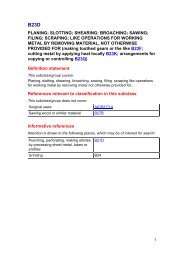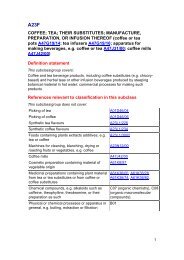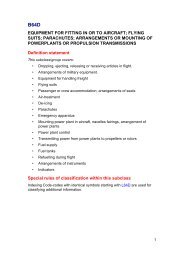A61K - Cooperative Patent Classification
A61K - Cooperative Patent Classification
A61K - Cooperative Patent Classification
You also want an ePaper? Increase the reach of your titles
YUMPU automatically turns print PDFs into web optimized ePapers that Google loves.
CPC - <strong>A61K</strong> - 2013.07 - page 74<br />
<strong>A61K</strong> 51/0442 . . . . . { having three-membered rings, e.g. aziridine }<br />
<strong>A61K</strong> 51/0444 . . . . . { having four-membered rings, e.g. azetidine }<br />
<strong>A61K</strong> 51/0446 . . . . . { having five-membered rings with one nitrogen as the only ring hetero<br />
atom, e.g. sulpiride, succinimide, tolmetin, buflomedil }<br />
<strong>A61K</strong> 51/0448 . . . . . . { tropane or nortropane groups, e.g. cocaine }<br />
<strong>A61K</strong> 51/0451 . . . . . . { having four such rings, e.g. phorphine derivatives, bilirubin,<br />
biliverdine ( hemin, hematin <strong>A61K</strong> 51/0472 ) }<br />
NOTE<br />
-<br />
Porphyrins or texaphyrins used as complex-forming compounds,<br />
i.e. wherein the nitrogen atoms forming the central ring system<br />
complex the radioactive metal, are classified in <strong>A61K</strong> 51/0485<br />
<strong>A61K</strong> 51/0453 . . . . . { having five-membered rings with two or more ring hetero atoms, at least<br />
one of which being nitrogen, e.g. tetrazole }<br />
<strong>A61K</strong> 51/0455 . . . . . { having six-membered rings with one nitrogen as the only ring hetero<br />
atom }<br />
<strong>A61K</strong> 51/0457 . . . . . . { Vesamicol }<br />
<strong>A61K</strong> 51/0459 . . . . . { having six-membered rings with two nitrogen atoms as the only ring<br />
hetero atoms, e.g. piperazine }<br />
<strong>A61K</strong> 51/0461 . . . . . { having six-membered rings with three nitrogens as the only ring hetero<br />
atoms, e.g. chlorazanil, melamine ( melarsoprol <strong>A61K</strong> 51/0472 ) }<br />
<strong>A61K</strong> 51/0463 . . . . . { having six-membered rings with at least one nitrogen and one oxygen<br />
as the ring hetero atoms, e.g. 1,2-oxazines }<br />
<strong>A61K</strong> 51/0465 . . . . . { having six-membered rings with at least one nitrogen and one sulfur as<br />
the ring hetero atoms, e.g. sulthiame }<br />
<strong>A61K</strong> 51/0468 . . . . . { having seven-membered rings, e.g. azelastine, pentylenetetrazole }<br />
<strong>A61K</strong> 51/047 . . . . . . { Benzodiazepines }<br />
<strong>A61K</strong> 51/0472 . . . . { containing heavy metals, e.g. hemin, hematin, melarsoprol }<br />
<strong>A61K</strong> 51/0474 . . . { complexes or complex-forming compounds, i.e. wherein a radioactive metal (<br />
e.g. 111In3+ ) is complexed or chelated by e.g. a N2S2, N3S, NS3, N4<br />
chelating group }<br />
NOTE<br />
-<br />
<strong>Classification</strong> is made according to the nature of this complex-forming<br />
agent, if it is either an uncommon or new complexing agent (not the usual<br />
DTPA, DOTA, DOTP, MAG3 etc...groups) that forms the real contribution<br />
to the claimed invention (radioimaging or radiotherapeutic agent), or if it is<br />
not conjugated to any further molecule, e.g. which is not conjugated to a<br />
polymer, peptide, protein or antibody. In that latter case, the radioactive<br />
agent is e.g. a radioactive metal chelate<br />
<strong>A61K</strong> 51/0476 . . . . { complexes from monodendate ligands, e.g. sestamibi }<br />
<strong>A61K</strong> 51/0478 . . . . { complexes from non-cyclic ligands, e.g. EDTA, MAG3 }<br />
<strong>A61K</strong> 51/048 . . . . . { DTPA ( diethylenetriamine tetraacetic acid ) }<br />
<strong>A61K</strong> 51/0482 . . . . { chelates from cyclic ligands, e.g. DOTA }<br />
<strong>A61K</strong> 51/0485 . . . . { Porphyrins, texaphyrins wherein the nitrogen atoms forming the central ring<br />
system complex the radioactive metal }





